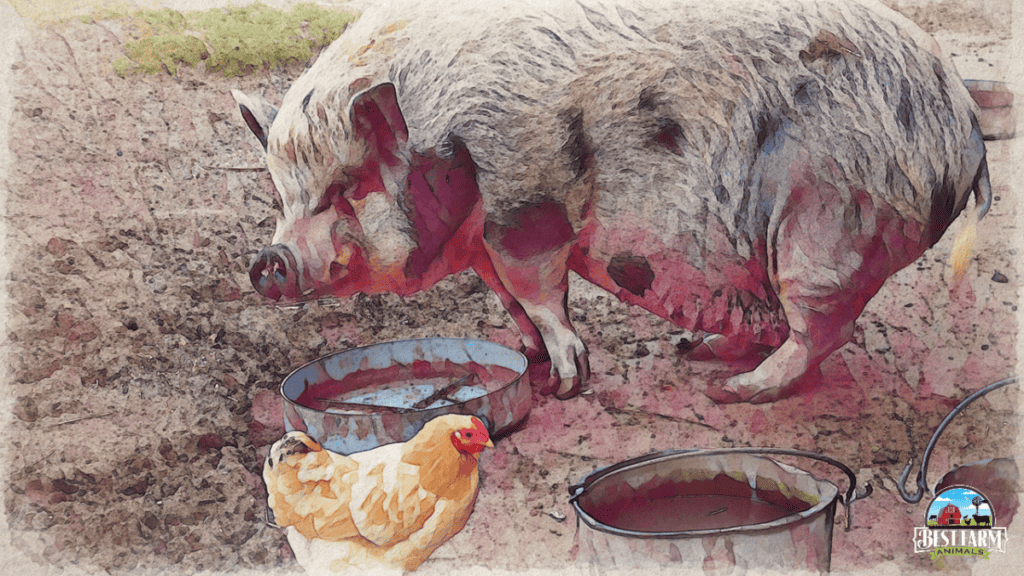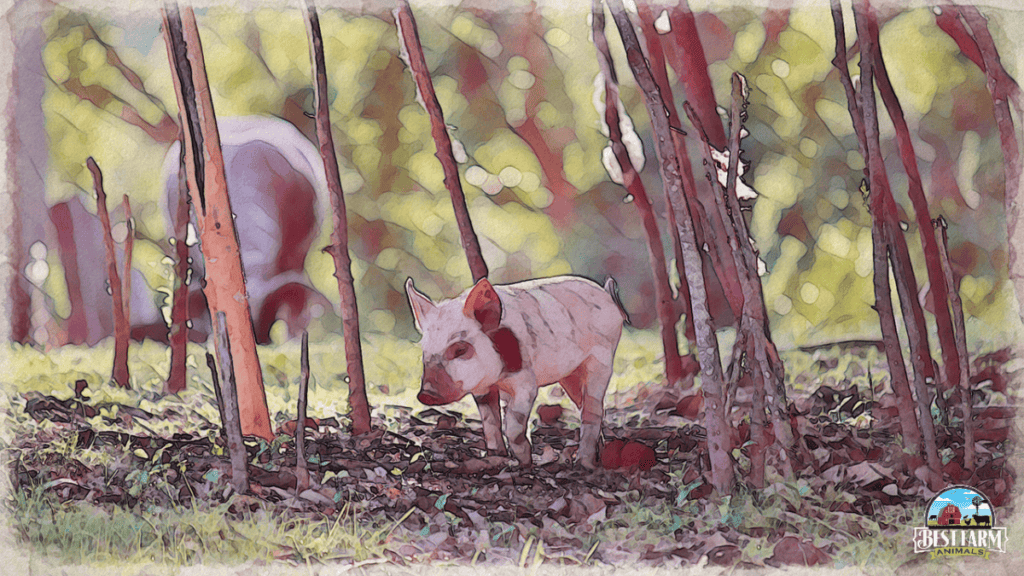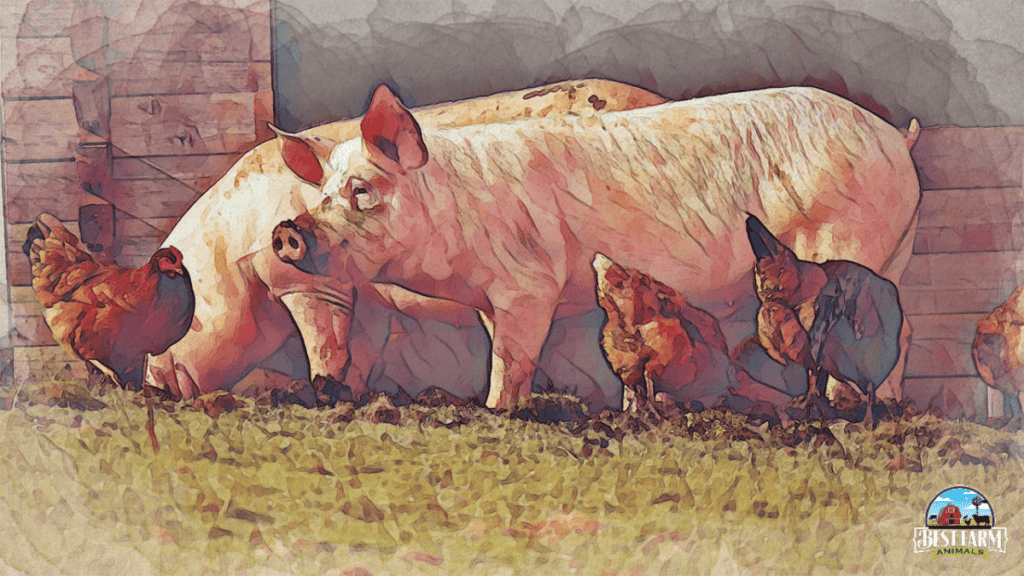Conventional wisdom keeps chickens and pigs housed and living in separate areas. There are dangers in housing pigs and chickens together.
But, with care and attention, chickens and pigs can be trained to live together safely.
9 Steps to Successfully Raising Chickens And Pigs Together
Pigs and chickens have very little in common, and it isn’t just their size. However, this doesn’t mean they can’t be raised together (under the right conditions).
In fact, a chicken and pig can benefit one another.
For one, the pigs provide protection against predators, and the chickens keep the living area free from pesky insects.
But, before housing these two animals together, weigh the pros and cons and look into the risks involved for both animals.
There are a few things to keep in mind if you decide to allow your chickens access to where you plan to keep your pigs.
1. Space: Make sure you have the room the pigs need
To house chickens and pigs together, ensure you have the room the pigs need. Pigs without room to explore and rut will find other things to do to ease their boredom.

That may include chasing chickens, which could harm the chickens.
In enclosed areas, chickens may be unable to escape the pig chasing them. It would be too easy to corner a chicken, making it more of a snack than a friend.
Space also helps to keep chickens and pigs from getting sick.
2. Get your pigs as young as you can
Piglets are more accepting than grown pigs usually are. The younger the piglets- the easier it will be to successfully cohabitate pigs and chickens.
It tends to be a “can’t teach an old dog new tricks” type of situation.
Adults may be too set in their own ways and not as accepting of intruders, even beneficial ones. By getting them young, they will see chickens as always being a part of their lives.
3. Be wary of hormonal issues and changes in the swine
Both unfixed males and pregnant females can become highly aggressive because of hormonal issues. This poses an issue when a chicken and pig are together.
Once a chicken is killed, even accidentally, it may be too late to allow them around the chickens again. Oftentimes pregnant a sow needs to be separated due to their aggressive nature and doing this before an attack is best.
4. Rescue pigs can be an issue when housed with chickens
While some rescue pigs can make perfect loving pets, others may have become aggressive from constant or severe abuse.

While rescue pigs can still be good animals and pets to people, it may make them aggressive around both humans and other animals, especially smaller animals like chickens.
Unfortunately, rescue pigs tend to be too much of a wildcard for other animals.
5. Be aware of outside influences that affect pigs
Pigs are often aware of things that humans get used to or don’t notice anymore.
From a wild roaming boar to an aggressive pen mate, the kindest of pigs can be influenced negatively, which could put your chickens at risk.
Animals tend to learn from each other, which can be good or bad. If you see signs of aggression in one pig, separate it from the bunch immediately so the others do not pick up on it.
6. Boredom can also cause a pig to chase the chickens
Bored pigs can become dangerous pigs for hens. If there is enough room for the hens to really run, the pig will probably chase it for something to do.
However, if there is limited space, pigs may catch the chicken, which is where it becomes dinner.
Pigs do like to chase, but if the chicken can’t be cornered, they will probably be fine.
7. Look into the general temperament of different breeds of swine
Some swine breeds are more aggressive than others and are more likely to go after anything that enters their territory, while other breeds may be more willing to accept other species entering their area without issue.
8. Spend time with both species
Showing the chickens and pigs your attention and affection will help calm and reassure them. Pigs and chickens are more likely to remain calm, and there would be less risk of aggression.
It will also help to remove their fear and help them to be more pet-like, even if this isn’t your intended goal.
How To House Chickens And Pigs Together Summary:
- Make sure you have the room pigs need
- Add more from the list here
- Introduce the chickens to the pigs when the pigs are young. Piglets will accept the chickens better than adult pigs.
- Consider sterilizing the pigs, as raging hormones can make them aggressive toward the chickens.
- Keep the chickens separate from pregnant sows, as the sow may become territorial and aggressive.
- Don’t house rescue pigs with chickens. Unfortunately, some rescue pigs can be aggressive from past trauma or abuse.
- Separate bad influences from the pen. Pigs can pick up bad habits from aggressive pen mates.
- Provide stimulation as boredom can make pigs destructive and aggressive.
- Research different pig breeds, and choose a breed with a good temperament and that gets along with other animals.
- Give both the pigs and chickens the same amount of attention and affection.

Do Pigs Eat Chicken Eggs?
Pigs can and will eat chicken eggs if given a chance. The biggest problem with this is that though the pigs may leave the chickens alone, eggs can’t run, and they make for an easy snack.
One of the main reasons that homesteaders or small farm owners keep chickens is to get fresh eggs.
When you house a chicken and pig together, your ability to get at these eggs may be negatively impacted. Your chickens may feel comfortable laying their eggs in the pig area because the pigs offer them protection.
You may end up losing half or more of your eggs when your pigs get to them first. Plus it can be a pain to search through the pigs’ area to find the eggs.
Even if the pigs don’t eat the eggs, they are more likely to get trampled and ruined.
Remember that pigs are intelligent creatures. Once they notice that eggs are getting laid in a certain spot, especially if you find that spot, they may start going right behind the chicken and snagging the egg before you even have a chance to find it.
Just because a pig will leave the chickens alone does not mean the eggs are safe. Those become fair game, as far as the pigs are concerned.
- Pigs are more likely to eat eggs
- Eggs may be trampled and ruined
- Difficult to go through a pig pen and all the dirt and filth to find the eggs
Do Pigs and Chickens Eat The Same Food?
Chickens and pigs can eat the same food, but not all the time. Your chickens may find that they prefer the taste of the pig grower feed, which means they won’t eat as much chicken feed.
But, your hogs may also eat your chicken feed. This is usually more expensive. The only way to combat this is to get your chickens to eat pig concentrate feed instead.
How do you feed pig concentrate to broilers?
To feed pig concentrate to broilers, you’ll need to add in additional maize to make a broiler finisher meal. To do this, mix one part pig concentrate to two parts ground maize.
Chickens can be fed this meal from 22 days old and by 33 days they should have consumed around 6.17 pounds of finisher meal.
In some places, such as Canada, the pig and chicken feeds are very similar. It depends on each supplier. Check with your supplier to see if feeding your chickens hog food would be safe. This can help save money in the long run.
How to Feed Chickens Eggshells While Housing With Pigs
Swine food is definitely lacking the extra calcium that laying hens need to make the shells. This can be fixed by offering the chickens either eggshells or oyster shells. While eggshells would normally just be tossed or composted, they can be fed right back to the chickens that laid then, if some steps are taken.
- Rinse the shells really well to get any egg remains off of them. You don’t want your chickens to develop a taste for raw eggs.
- Dry and toast them in the oven. This helps to break down the shells to make it more digestible, to both chickens and humans (optional).
- Break them up really well. You can even use a food processor or coffee grinder to turn them into powder. I usually just crush my eggshells into pieces.
- Either feed them straight to the chickens or offer it up mixed in with a treat. You could easily gut load some mealworms as chickens love those as treats.
- Feed away from the pigs since the chickens are the ones who need the extra calcium. Plus you don’t want to encourage your pigs to develop a liking for eggs.

Assuming that the feed is otherwise the same, any nutrients other than the calcium will probably be picked up during foraging, at least in the warmer months.
You may need to pick up something like a flock block (yes, its a real thing) that has additional minerals and vitamins that chickens need for during the winter months.
Suitable Food For Both Pigs And Chickens
There are foods that are healthy for both chickens and pigs. You can give them table scraps.
Chickens shouldn’t get salty table scraps but will love fresh fruits and vegetables you don’t want to feed your family. Pigs also love this.
Things that are starting to get overripe like:
- Bananas
- Tomatoes
- Carrots
- Broccoli
- Lettuce
- Spinach
- Berries
- Apples
Pigs and chickens both enjoy eating vegetables and fruit that are overripe and soft such as bananas, tomatoes, carrots, broccoli, lettuce, spinach, berries, and apples.
You can also look into sending scraps to your animals rather than to the compost pile. When humans prepare food, we tend to skin carrots, cut off the end of berries and not eat the outer skin or rind, and these things can make good treats for both pigs and chickens. They can be added as a slop or be given individually. This can include things like:
- Watermelon rind
- Banana skins
- Fruit stems
- Apple cores
- Vegetable stalks
- Leftovers after meals not worth saving
Pig slop can include fruits such as watermelon rind, banana skins, fruit stems, and apple cores. Leftover vegetables such as vegetable stalks, broccoli, carrots, and potatoes also work well. You can even add scraps from your dinner table, such as leftover rice, pasta, or bread.

Plus there is the vegetation that is leftover from a garden that can be fed as well. Once the annual growing season is over, the plants can be pulled up and fed to the animals as well.
If these things are fed in a trough, it will give both the pigs and the chickens a chance to get some yummies that regular feed does not provide.
Since both animals are omnivores, things like bones and fat could be appreciated too. However, I would put some thought into things like chicken bones. While both will eat them, if fed to the pigs, they may decide that chicken is a tasty snack anytime.

